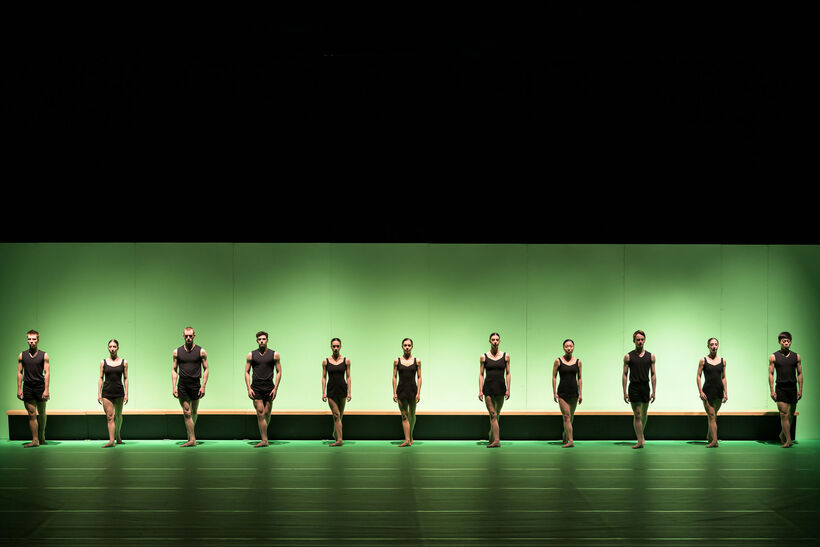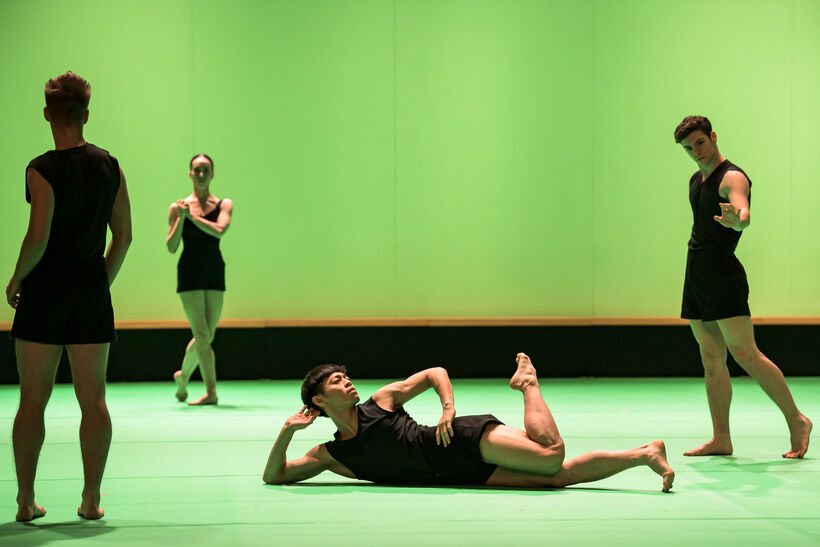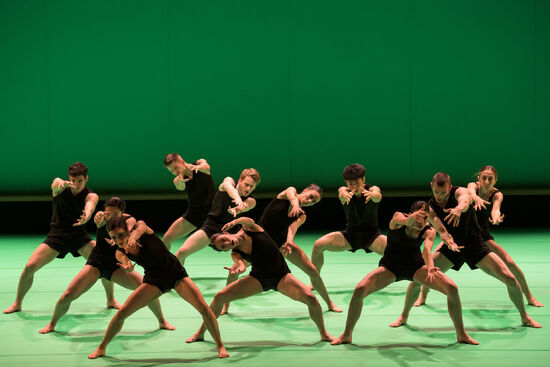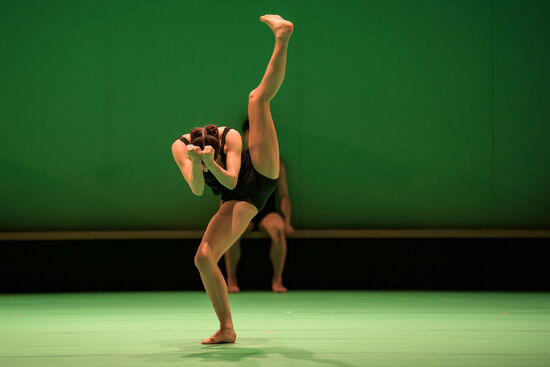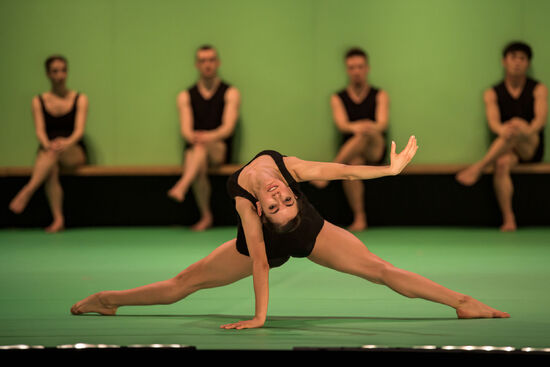Naharin's provocative Hora put Ostrava on its feet
The National Moravian-Silesian Theatre Ballet Company has long amazed its audiences with its courage to present not only classical ballet titles but also famous contemporary choreographers. Inviting Ohad Naharin, a choreographic world star of Israeli origin, is the boldest step yet. The preparation of his works puts high demands on the performers; in the spirit of the gaga system, he encourages to open up hitherto silent energy channels and to work with the body in a new way. Given the conditions in which most regional ballet companies have to operate, it is almost a miracle how the dancers have coped with such a morsel.
Hora is a spectacular and steep production that combines maximum energy bursts with a soothing detachment. And yet the correspondence of its title with the Czech word "hora" (mountain) is purely coincidental. When Ohad Naharin created it for his ensemble Batsheva in 2009, he was inspired by the word for folk dance in Balkan languages, knowing that in Spanish-speaking areas it is a term for time or hour. If I had to call the work with one Czech word, I would probably use the word "hra" (game). The choreographer himself said that for him the stage is one big playground on which different situations can unfold.
The only prop on the stage, all in green, is a long bench placed near the back wall (designed by Amir Raveh). Eleven dancers take turns entering the "playing field" or sitting on the bench to observe the action in front of them. They are dressed in simple black sleeveless costumes with short pants that perfectly highlight the silhouettes of their bodies (costumes created by Naharin's wife Eri Nakamura). The image changes only slightly over the course of the hour-long performance, with the scene darkening a bit at certain moments and red tones joining the dazzling green towards the end. The light and set design were designed by none other than Avi Yona Bueno, aka Bambi, who, otherwise without any significant scenic effects or changes, has maintained the backdrop for a "green, disturbing and hauntingly beautiful world," as the subtitle of the piece reads.
An important companion to the work is the musical composition. Award-winning Japanese composer Isao Tomita (1932-2016) has created digital arrangements of familiar melodies for Hora, whose references will put a smile on the face of all viewers. The seemingly disparate melodic themes of the famous pieces come together to form a logical dramatic arc full of peripeteia and emotion. Debussy's Afternoon of a Faun, Mussorgsky's Pictures at an Exhibition, Williams's main theme from Star Wars, the Cosmic Fantasy from Strauss' poem Thus Spoke Zarathustra, Wagner's overture to the opera Tannhäuser, Edvard Grieg's Solveig’s Song and many others merge in a witty musical game. And the dancing bodies join in again. Sometimes they seem to get carried away by the change of the melody, sometimes the choreography deliberately goes against the mood of the music, complements it, multiplies it or opposes it. The relationship between the dance and the music changes at every moment, so it does not let you calm down from the fulfilled expectations and still encourages you to pay attention.
If you are a dancer, watching Naharin's movement composition will bring you physical tension. The performers' bodies are constantly tossed about in various extreme positions, stretched without respite in high ranges, explosive jumps, crouched lurking positions, without stopping at 150% concentration. You can never guess which movement will follow, Naharin always surprises you with a total reversal, a collapse of form, to rebuild a new perfect pose. He plays with the human body, drawing with it a plethora of images that come alive in your mind. He tells stories not of human lives, but of human bodies. Solos alternate with duets, trios, quartets, quintets, sextets... and the performance of the entire group of elevent. Five men and six women conquer the stage and their bodies imply various moments in life – fear, courage, romance, wit, interplay, loss, passion, conflict - any association your brain allows you to recall.
The entire work is a tribute to the dancers and the abilities of their bodies. The Ostrava company proved that it is worthy of the production. Despite the visible nervousness and initial caution, they gradually worked up to top performances during the opening night. Surprisingly, the greatest strength and calmness was shown in the ensemble passages, in which it was clear how the dancers drew strength from their togetherness, team, unity. And although each of the eleven soloists had many opportunities to show their individuality and uniqueness, it was in the group scenes that they all shone the brightest.
Some of the solos and duets, otherwise done in perfect form, still lacked a little of the attitude, ease, cheekiness and satisfaction that all future reprises will surely bring, in which the nervousness of respect for a world masterpiece will gradually subside. Most "at home" in their roles were Rita Pires and Aurora Donadiós, whose energy seemed inexhaustible. Shino Sakurado and Yu Matsumoto displayed amazing physical dispositions. More sass would have suited Ida Frau and Arianna Marchiori, but they were no match for the others in form. The five men were energetically very balanced and let their egos go more compared to the girls. Rei Masatomi impressed me with his speed and power, Mario Sobrino with his provocative elegance, Barnaby James Packham with his natural masculine authority, Patryk Zamojski with his youthful vigour, and Gene David Goodman with his refined delicacy.
Hora is an experience that requires not only trained and open dancing bodies, but also a trained and open dance audience. The company was greatly aided by ballet master Natasha Novotna, an experienced dancer and the only Czech certified gaga instructor, who had an inkling of how to prepare the company for Naharin's way of working. Lenka Dřímalová, the head of the Ostrava Ballet, has been tirelessly educating the audience, ready to perceive the world's choreographic elite, in Ostrava for many years. Hopefully, these two conditions will meet in a good mood and not only the subscribers will appreciate what a gem is presented to them. Naharin's Hora by the National Moravian-Silesian Theatre Ballet Company is a unique treat in the Czech Republic, and it is worth travelling to Ostrava even from the more distant parts of the country to see it.
Written from the premiere on 16 March 2023, Jiří Myron Theatre, Ostrava.
Hora
Choreoraphy: Ohad Naharin
Light and set desing: Avi Yona Bueno (Bambi)
Music setting: Isao Tomita
Sound design: Maxim Waratt
Costume designer: Eri Nakamura
Bench design: Amir Raveh
Staging: Matan David, Hani Sirkis
Ballet master: Nataša Novotná




